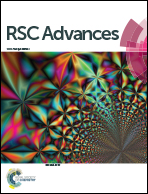Acceptor–donor–acceptor small molecules based on derivatives of 3,4-ethylenedioxythiophene for solution processed organic solar cells†
Abstract
Three simple semiconducting acceptor–donor–acceptor (A–D–A) small molecules based on an electron-rich (3,4-ethylenedioxythiophene) EDOT central core have been synthesised (DIN-2TE, DRH-2TE, DECA-2TE) and characterised. Organic photovoltaic (OPV) devices incorporating these materials have been prepared and evaluated. The physical properties of the molecules were characterised by TGA, DSC, UV/vis spectroscopy and cyclic voltammetry. The optical HOMO–LUMO energy gaps of the molecules in the solid state were in the range 1.57–1.82 eV, and in solution 1.88–2.04 eV. Electrochemical HOMO–LUMO energy gaps determined by cyclic voltammetry were found to be in the range 1.97–2.31 eV. The addition of 1% 1,8-diiodooctane (DIO) to photoactive blends of the A–D–A molecules and PC71BM more than doubled the power conversion efficiency (PCE) in the case of DRH-2TE:PC71BM devices to 1.36%.


 Please wait while we load your content...
Please wait while we load your content...